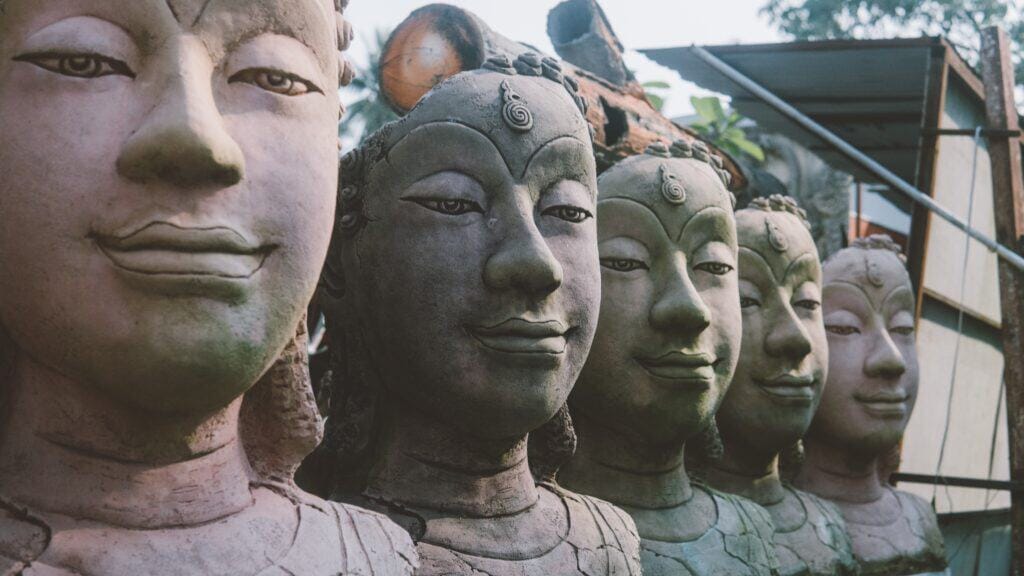The Five Aggregates are a fundamental concept in Buddhism that helps to understand the nature of reality and the path to enlightenment. The aggregates, also known as skandhas, are a way to understand the human experience and how it is constructed. They are the five aspects that make up a person: form, sensation, perception, mental formations, and consciousness.
According to Buddhist teachings, everything in the world is dependent on other things and is constantly changing. The Five Aggregates are no exception. They are interdependent and constantly changing, and it is through understanding the nature of these aggregates that one can begin to understand reality and the path to enlightenment. The aggregates are also linked to the concept of samskara, which refers to the mental and physical conditioning that shapes a person’s experience. Understanding the aggregates can help one to recognize the impermanence and unsatisfactoriness (dukkha) of existence and to realize the not-self (anatta) nature of the self.
In essence, the Five Aggregates provide a framework for understanding the nature of human experience and how it is constructed. By understanding the interdependence and impermanence of the aggregates, one can begin to see the world more clearly and ultimately reach enlightenment. The concept of the Five Aggregates is an essential part of Buddhist teachings and provides a valuable tool for anyone seeking to understand the nature of reality and the path to enlightenment.
The Five Aggregates Explained
The Five Aggregates, also known as the Five Skandhas, are the five components that make up a sentient being according to Buddhist philosophy. These aggregates are Form (Rupa), Sensation (Vedana), Perception (Samjna), Mental Formations (Samskara), and Consciousness (Vijnana).
Form (Rupa)
Form or Rupa refers to the physical aspect of a sentient being. This aggregate includes the body and all its physical properties such as shape, color, and texture. It also includes the sense organs such as the eyes, ears, nose, tongue, and body.
Sensation (Vedana)
Sensation or Vedana refers to the experience of pleasure, pain, or neutrality that arises from contact with the external world. This aggregate includes the physical sensations that we feel through our sense organs such as touch, taste, smell, sight, and sound.
Perception (Samjna)
Perception or Samjna refers to the ability to recognize and identify objects and experiences. This aggregate allows us to distinguish between different objects and experiences and to give them names. It is through perception that we are able to make sense of the world around us.
Mental Formations (Samskara)
Mental Formations or Samskara refers to the mental processes that arise in response to sensory input. This aggregate includes thoughts, emotions, and volitions. Mental formations are influenced by past experiences and can lead to the creation of habits and tendencies.
Consciousness (Vijnana)
Consciousness or Vijnana refers to the awareness or consciousness that arises in response to sensory input. This aggregate includes the different types of consciousness such as visual consciousness, auditory consciousness, and so on. Consciousness is what allows us to experience the world around us.
In summary, the Five Aggregates are the components that make up a sentient being according to Buddhist philosophy. Each aggregate plays a crucial role in shaping our experience of the world. By understanding the nature of these aggregates, we can gain insight into the workings of the mind and ultimately achieve liberation from suffering.
The Role of the Five Aggregates in Buddhism
The Five Aggregates (also known as Skandhas) is a fundamental concept in Buddhism. They refer to the five aspects that make up a person’s mental and physical existence. These aggregates are Form (Rupa), Sensation (Vedana), Perception (Sanna), Mental formation (Sankhara), and Consciousness (Vinnana).
According to Buddhist teachings, the Five Aggregates are interdependent and constantly changing. They are not permanent entities, but rather a collection of ever-changing phenomena. The Five Aggregates are used to explain the nature of reality and the human experience.
The first aggregate, Form (Rupa), refers to the physical body and all the material objects that make up the world around us. It includes the Four Great Elements (solidity, fluidity, heat, and motion) and their derivatives, such as the five sense organs (eye, ear, nose, tongue, and body) and their corresponding objects (visible form, sound, odor, taste, and tangible things).
The second aggregate, Sensation (Vedana), refers to the physical and mental sensations we experience when we come into contact with the world around us. These sensations can be pleasant, unpleasant, or neutral.
The third aggregate, Perception (Sanna), refers to our ability to recognize and categorize the objects and experiences we encounter. Perception allows us to distinguish between different objects and experiences and to give them meaning.
The fourth aggregate, Mental Formations (Sankhara), refers to the mental processes that shape our thoughts, emotions, and behavior. These mental formations include volition, attention, thinking, and reaction. They are responsible for our biases, habits, and karma.
The fifth aggregate, Consciousness (Vinnana), refers to our awareness of the world around us. It is the subjective experience of being conscious. Consciousness is closely related to the other four aggregates and is influenced by them.
In Buddhism, the Five Aggregates are used to explain the nature of suffering (dukkha) and the path to enlightenment. According to Buddhist teachings, clinging to the Five Aggregates leads to suffering because they are impermanent and constantly changing. By understanding the interdependence and impermanence of the Five Aggregates, one can develop wisdom and insight into the nature of reality and the self.
In summary, the Five Aggregates play a crucial role in the Buddhist understanding of the human experience. They are used to explain the nature of reality, suffering, and the path to enlightenment. By understanding the interdependence and impermanence of the Five Aggregates, one can develop wisdom and insight into the nature of the self and the world around us.
The Five Aggregates in Meditation
When it comes to meditation, understanding the Five Aggregates can be incredibly useful. By recognizing the Five Aggregates as they arise in one’s experience, a meditator can gain insight into the nature of their mind and the world around them.
In meditation, one can observe the Five Aggregates in action. For example, when a meditator focuses on their breath, they are experiencing the aggregate of Form (rupa). As they become more aware of their breath, they may also become aware of the aggregate of Sensation (vedana), as they feel the sensation of the breath moving in and out of their body.
As the meditator continues to observe their breath, they may also become aware of the aggregate of Perception (samjna), recognizing the breath as a concept or phenomena. They may also become aware of the aggregate of Mental Formations (sankhara), as they notice their mind wandering or becoming distracted.
By paying attention to the Five Aggregates in this way, a meditator can gain insight into the nature of their mind and the world around them. They can recognize how their mind creates concepts and labels, and how these concepts and labels can lead to suffering.
Through mindfulness and awareness, a meditator can learn to observe their thoughts and emotions without becoming attached to them. They can recognize the impermanence of all phenomena and the interconnectedness of all things.
In summary, the Five Aggregates can be a useful tool for meditators to gain insight into the nature of their mind and the world around them. By recognizing the Five Aggregates as they arise in their experience, a meditator can cultivate mindfulness, awareness, and insight.
The Five Aggregates and the Concept of Empty Self
In Buddhism, the concept of the “empty self” is closely related to the Five Aggregates, which are the components that make up an individual’s experience of reality. The Five Aggregates are form, sensation, perception, mental formations, and consciousness.
The empty self is the idea that there is no permanent, unchanging self or soul that exists independently of the Five Aggregates. Instead, the self is seen as a constantly changing, impermanent construct that arises from the interaction of the Five Aggregates.
This concept of the empty self is closely related to the Buddhist idea of reality as being “empty” or “devoid of inherent existence.” This means that everything in the world, including the self, is not a fixed, separate entity but rather a seamless, interconnected web of causes and conditions.
The Five Aggregates are often used to help individuals understand the concept of not-self or anatta, which is the idea that there is no permanent, unchanging self or soul that exists independently of the Five Aggregates. Instead, the self is seen as a constantly changing, impermanent construct that arises from the interaction of the Five Aggregates.
By understanding the concept of the empty self and the impermanence of the Five Aggregates, individuals can begin to let go of their attachment to the idea of a fixed, separate self. This can lead to a greater sense of peace and freedom from suffering, as individuals come to see themselves as part of the seamless, interconnected web of reality rather than as separate, isolated entities.
Overall, the Five Aggregates and the concept of the empty self are key components of Buddhist philosophy and practice. By understanding these concepts, individuals can begin to let go of their attachment to the idea of a fixed, separate self and come to see themselves as part of the seamless, interconnected web of reality.
The Five Aggregates in Pali and Sanskrit Literature
The Five Aggregates, also known as the Five Skandhas, is a central concept in Buddhist philosophy. The Pali and Sanskrit literature provides a detailed account of the Five Aggregates and their role in Buddhist teachings.
In Pali literature, the Five Aggregates are referred to as “pañca khandha.” The term “khandha” means “heap” or “aggregate.” The Five Aggregates are:
- Rupa: form or matter
- Vedana: feelings or sensations
- Sanna: perception or recognition
- Sankhara: mental formations or volitional activities
- Vinnana: consciousness
Similarly, in Sanskrit literature, the Five Aggregates are referred to as “pañca skandha.” The term “skandha” means “aggregate” or “heap.” The Five Aggregates are:
- Rupa: form or matter
- Vedana: feelings or sensations
- Samjna: perception or recognition
- Samskara: mental formations or volitional activities
- Vijnana: consciousness
Both Pali and Sanskrit literature emphasizes that the Five Aggregates are not permanent entities but rather impermanent and constantly changing. The Buddha taught that the Five Aggregates are not self or soul, but rather a collection of constantly changing and interdependent phenomena.
The Five Aggregates are also closely related to the concept of “dukkha,” or suffering. The Buddha taught that the attachment and clinging to the Five Aggregates leads to suffering. By understanding the impermanence and interdependence of the Five Aggregates, one can attain liberation from suffering.
In conclusion, the Pali and Sanskrit literature provides a detailed account of the Five Aggregates and their role in the Buddhist teachings. The Five Aggregates are an essential concept in Buddhist philosophy and are closely related to the concept of suffering and liberation.













